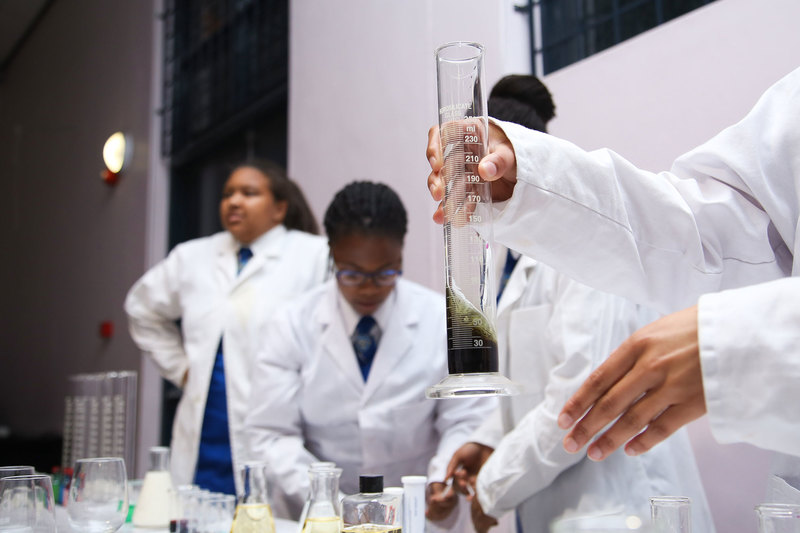Effecting change in STEM must start at school level
02 June 2021 | Story Niémah Davids. Photo Supplied. Read time 6 min.
Dr Zina Ndabeni made history when she joined the University of Cape Town’s (UCT) Department of Physics in 2020. As the first black South African woman to take up an academic role in the department, Dr Ndabeni said there’s serious work to be done to nurture young black students in the fields of science, technology, engineering and mathematics (STEM).
Ndabeni believes that with the right approach, anything is possible. As a changemaker herself, she said she has big plans to be part of leading change in the department she has come to love, among colleagues who she holds in high regard.
After a whirlwind 2020, which included settling into her new job, learning the ins and outs of emergency remote teaching and learning, and getting to grips with the online workspace,
Ndabeni can finally breathe easy.

UCT News caught up with her for some insight on her journey at the university to date.
Niémah Davids (ND): When did you join UCT?
Zina Ndabeni (ZN): I joined UCT on 1 March 2020 – on the eve of the nationwide lockdown, and when things were still slightly normal for our country and for some parts of the world.
ND: Tell me a bit about your role in the Department of Physics.
ZN: I was appointed into a joint position between the Department of Physics and the iThemba LABS – the largest multidisciplinary national research facility in South Africa and the largest accelerator research facility in the southern hemisphere.
“A large part of my role is to strengthen the research relationship between iThemba LABS’ and the Department of Physics”.
A large part of my role is to strengthen the research relationship between iThemba LABS’ Fast Neutron Beams Facility, and the Metrological and Applied Sciences University Research Unit located in the Department of Physics. I am also involved in teaching first-year physics students, and I’ve really learned to love that.
ND: What are some of the challenges you’ve encountered in the past year?
ZN: Without a doubt it has got to be lockdown, learning to adapt to a new environment and getting to know new colleagues in the online space – that was a huge challenge for me. When the lockdown announcement was made, I’d only been at UCT for two weeks [and] I was still trying to find my way around our office.
In the second semester I was assigned an online class [and] this meant I needed to prepare for online teaching and learning. That process brought forth many challenges and many learnings but I received great support from my colleagues and our head of department, Professor Andy Buffler, was a champion. In a flash, I was teaching remotely.
ND: Have you been working on any interesting research projects lately?
ZN: Currently I form part of a large international collaboration to upgrade and redevelop iThemba LABS’ Fast Neutron Beams Facility to meet International Organization for Standardization reference standards. To reach this objective we (iThemba LABS and UCT) have partnered with the Institut de Radioprotection et de Sûreté Nucléaire in France; the National Physical Laboratory in the United Kingdom; the Die Physikalisch-Technische Bundesanstalt, Braunschweig und Berlin, in Germany; and the National Metrology Institute of South Africa (NMISA).
The facility is one of very few in the world that provides quasi-monoenergetic neutron beams from 30 MeV to 200 MeV. It was also nominated as the “designated metrology institute for medium and high-energy neutron measurements” in South Africa by the NMISA and the International Bureau of Weights and Measures.
I’m also leading a project that aims to design and construct a remote sample handling system for the iThemba LABS’ Fast Neutron Beam Facility. This project will enable sample irradiation near the neutron production area where neutron fluxes are enhanced. I am very excited about both these projects.
“Effecting change is going to take work, but we need to start at school level – that’s where we receive our foundations in science and maths.”
ND: As the first black South African woman academic in your department, what’s the kind of change that you’d like to see in the department and UCT more broadly?
ZN: Sadly, South Africa produces very few black and black women scientists, and even fewer in maths and physics. That has affected diversity and transformation at university level in the country.
Effecting change is going to take work, but we need to start at school level – that’s where we receive our foundations in science and maths. We need to focus more of our attention on schools in rural areas. There’s a huge knowledge gap between someone like me (who entered a laboratory and used a computer for the first time in university), and someone who attended a private school. It’s also said to be one of the leading causes for high drop-out rates among black learners. This is the reason we’re sitting with this problem, and we need corrective measures to change things.
We can do that by producing more role models for young black learners in the field in schools. Having someone that they can look up to and relate to will increase their awareness and we’ll reap the rewards in the end.
ND: What’s the biggest lesson you’ve learned since you joined UCT?
ZN: Optimism and resilience is so important. I am fortunate to be part of an optimistic and resilient university, where adversity is considered an opportunity to learn and develop new skills, and not to despair despite the challenges.
 This work is licensed under a Creative Commons Attribution-NoDerivatives 4.0 International License.
This work is licensed under a Creative Commons Attribution-NoDerivatives 4.0 International License.
Please view the republishing articles page for more information.




















































































































































































































































































































































































































































